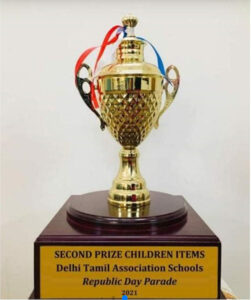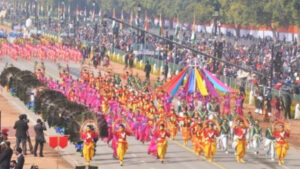Registered with the Registrar of Newspapers for India under R.N.I 53640/91
Vol. XXXI No. 15, November 16-30, 2021
Delhi’s ‘Madrasi’ school set to complete 100 years – II
by M.R. Narayan Swamy
(Continued from last fortnight)
Recalls A.R. Ramanathan, who passed out in 1975 and is a successful architect: “When one joined school, it was almost an extension of one’s home since the environment, students and even teachers were all from similar background.” DTEA school, he says, “invariably instilled a good value system that included simplicity and a down-to-earth approach to life, a clear sense of the ‘right’ and ‘wrong’, the importance of academic excellence underpinning a good future in life.”

The Cup the DTEA marching contingent won from the Government at the 2021 Republic Day parade in New Delhi.
Adds Anuradha Ravi, now a Bengaluru resident who studied in DTEA from 1959 to 1970 and retired from DRDO: “All our parents had the concept of simple living and high thinking ingrained in them and passed it on to their progeny. It was dinned into our ears that education alone would help us in life. The teachers never discriminated, whether one was a Joint Secretary’s son getting dropped by car or an ordinary family’s son walking to school in slippers.”
The miracle – it was nothing short of a miracle – eventually happened. In the 1950s and 60s and even in the early part of the 1970s, DTEA schools glowed like probably none of the 600 odd higher secondary schools in Delhi. This was the period when newspapers not only published the school-leaving Class 11 results but also the names of the 10 toppers (Merit List) for entire Delhi in all three streams – Science, Commerce and Arts (Humanities). Believe it or not, there was not a single year when DTEA was absent from the Merit List. Often DTEA students accounted for a third (at times more) of the total 30 in the Merit List. In 1962, a whopping 22 students made it to IIT just from Lodi Road! DTEA schools became the talk of the town. People wondered how could a school which did not charge donations produce such excellent results year after year. Some branches did not have a single failure in the final exam conducted by the Central Board of Secondary Education (CBSE).
The Tamil community was overjoyed.
Although there was a relationship of mutual respect between the staff and parents, there were hiccups. The Principals normally protected teachers from unreasonable criticism from parents. At the same time, legitimate complaints aired by parents was listened to and resolved. The early 1970s saw a major agitation by teachers against the DTEA Secretary who was accused of acting against the staff unfairly. Things came to a head in January 1974 when all 350 odd teachers squatted on the pavement outside the Moti Bagh School during a DTEA General Body meeting, forcing the unpopular Secretary to quit. The same year, there was violence blamed on senior students during a school event at Lakshmi Bai Nagar, leading to police intervention.

DTEA students marching in 2021 Republic Day parade in New Delhi.
While DTEA schools gave the highest importance to good academic performance, sports and other extra-curricular activities were relegated to the background. Talent outside of studies existed but it wasn’t encouraged, recalled architect Ramanathan. Also, poor infrastructure dogged DTEA in spite of having school buildings. Even with close to 1,000 students and staff, toilet facilities were bare minimal. Students would use their cupped palms to drink water straight from the tap but no one complained then about the lack of glasses!
It is impossible to fix one particular year but sometime in the 1980s the DTEA’s academic achievements began to flounder. Once the fall began, it could not be arrested. The schools also began – for more than one reason – to admit non-Tamils in large numbers. The Tamil majority was lost in the teaching arena. Barring exceptions, ex-students admit they are no more eager to send their own children to the DTEA. The ex-students – now parents and many grandparents – still love the school and do what they can for the alma mater but this stops with material help. According to former student D. Ranganathan, one important takeaway from DTEA is the deep and genuine bonds of friendship with many fellow students that has stood the test of time despite decades of zero contact.
Srinivasan, at whose house the Janakpuri school started, is one of the many who did not send his children to DTEA. He reasons: “Unfortunately, in later years, everything became commercialized. People in the management committee expected returns for services rendered. The standard of education was impacted along with moral principles.”A Tamil woman teacher still in service said on the condition of anonymity: “The changing profile of the students and teachers and a very different management is largely to blame for the poor academic results now.”
Can DTEA regain its lost glory? Will DTEA become a wholly Tamil school again? Does it have to? These are some of the questions DTEA grapples with,almost a century after it was formed and just when it has opened its eighth branch in Mayur Vihar in east Delhi.
(Concluded)


Pingback: A papier‑maché human anatomical model in the Madras Medical Establishment in the 1830s « Madras Musings | We Care for Madras that is Chennai
Pingback: Delhi’s ‘Madrasi’ school set to complete 100 years « Madras Musings | We Care for Madras that is Chennai